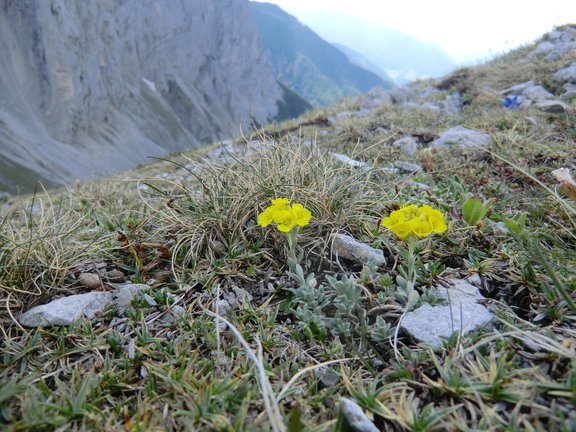
Hochschwab-Alyssum (Alyssum neglectum). This species, which was only recently described in 2014 under the leadership of P. Schönswetter, only occurs worldwide on the eastern Hochschwab massif (Styria). The species is very rare and the small populations are severely threatened by the consequences of global warming (increasing vegetation cover). Genetic monitoring would provide a crucial basis for the future management of this species and ensure its long-term survival. Photo: Zacharias Schäle & Marianne Magauer / University of Innsbruck.
Austria is home to around 50 endemic, non-apomictic flowering plants. Most of them occur in the Alps, clustered near known glacial refugia on the southern and eastern edge of the Alps. The region that harbors the most endemics, exclusively restricted to Austria, are the Northern Limestone Alps (NLA). The reason for this is the lack of glaciation in this region, especially east of River Enns.
In view of the purely Austrian distribution of the endemics of the NLA, Austria bears an extremely great responsibility for the conservation and protection of these "botanical crown jewels" and their genetic diversity. The endemics of the NLA are also witnesses to an eventful evolutionary past, and their genetic heritage allows conclusions to be drawn about the vegetation and climate history of the NLA and Austria in general. Despite this great responsibility, there have been no systematic genetic studies or even genetic monitoring to date.
This project aims to provide the basis for genetic monitoring of eight selected endemic plant species of the northeastern Limestone Alps (Achillea clusiana, Alyssum neglectum, Callianthemum anemonoides, Campanula pulla, Draba stellata, Euphorbia saxatilis, Noccaea crantzii, Pulmonaria kerneri). The genomic DNA of 10 individuals each from a total of 150 populations studied will be sequenced using restriction-site associated DNA sequencing (RADseq) in order to determine parameters that reflect the genetic diversity and genetic differentiation of the populations. For the first time, a systematic and generally applicable method for genetic monitoring of wild plants in Austria is to be established.
Based on the knowledge gained, concrete conservation recommendations can be derived. The collected indices not only allow a characterization of the current state, for example the identification of particularly diverse populations worthy of protection or particularly threatened, genetically impoverished populations, but also make it possible to develop differentiated and timely management measures for the future.
The project is led by Prof. P. Schönswetter and carried out in collaboration with Dr. Karin Tremetsberger, Dr. Manuela Winkler and Dr. Matthias Kropf from the University of Natural Resources and Life Sciences, Vienna.
